Almost three years ago our steps led us to the golden land known as Myanmar. That was before the election when the LND won a landslide victory. What was striking at the time was the people’s hope for a more democratic regime. We were surprised because the Burmese were talking more or less freely about politics back then. So after getting off the plane, we plunged into a swirl of cars and a concert of horns and eventually reached our hotel in Yangon after driving through a giant traffic-jam that went for miles and miles.
I was travelling with my faithful Ricoh GR, of course, but did not take a single photo on the first day as we were both too tired by the long journey and needed rest before visiting that bustling city. The two things that really struck us on our second day, after a good rest, was the hectic traffic and the difficulty in crossing the roads. It took us about three or four minutes to cross any road as we were afraid of being run over by the never-ending speeding . After a couple of days, however, we realised it was quite safe to venture into the traffic.
The second impression was the friendliness and kindness of people, always willing to help and smiling. This time, although Yangon is a colourful city and the golden light in the Shwedagon Pagoda is absolutely amazing, I prefer the black and white conversions of the images as they seem more appropriate to my eyes.
Our first visit was to the harbour in Yangon as we live not far from the harbour in Le Havre and always visit harbours wherever there is one.
We had mixed feelings about it as we were struck by the poverty of some dockers’ wives begging under any bridge leading to the quaysides. We were told that people working on the harbour had no secure job and were enrolled on a daily basis when there was work. Once you reach the quaysides you have to step carefully as they are made of rough, disjointed or broken wooden boards. You can often see the water of the Ayerwaddy beneath your feet. However small traditional boats ferry families to and fro across the river. The size difference between these boats and the enormous tankers is quite a sight. We then went to the ferry terminal which was busy because some Burmese consider it’s not that safe to cross the river on the small traditional boats
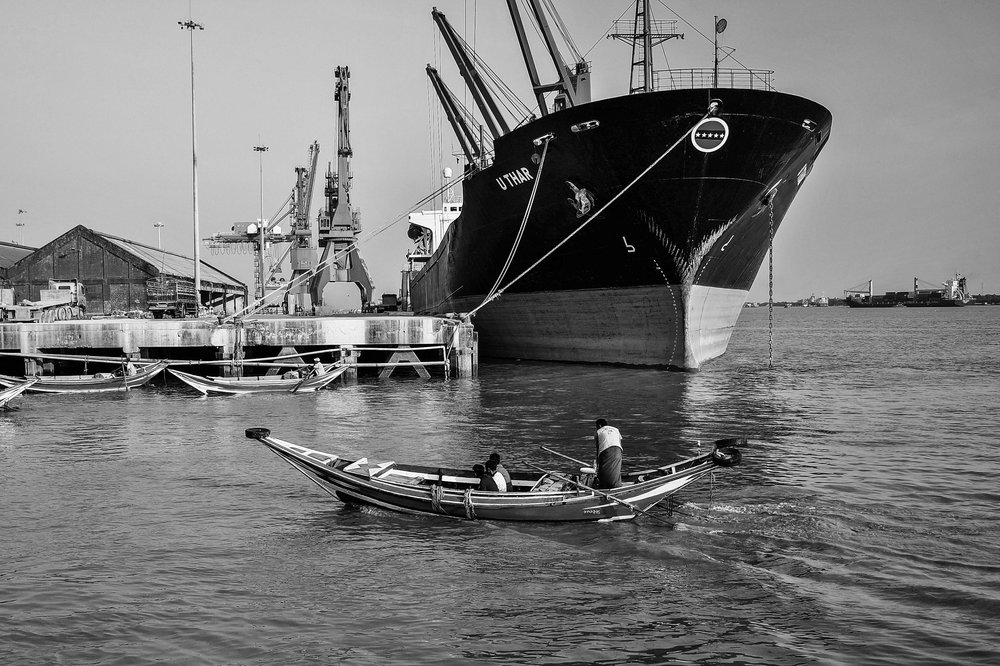
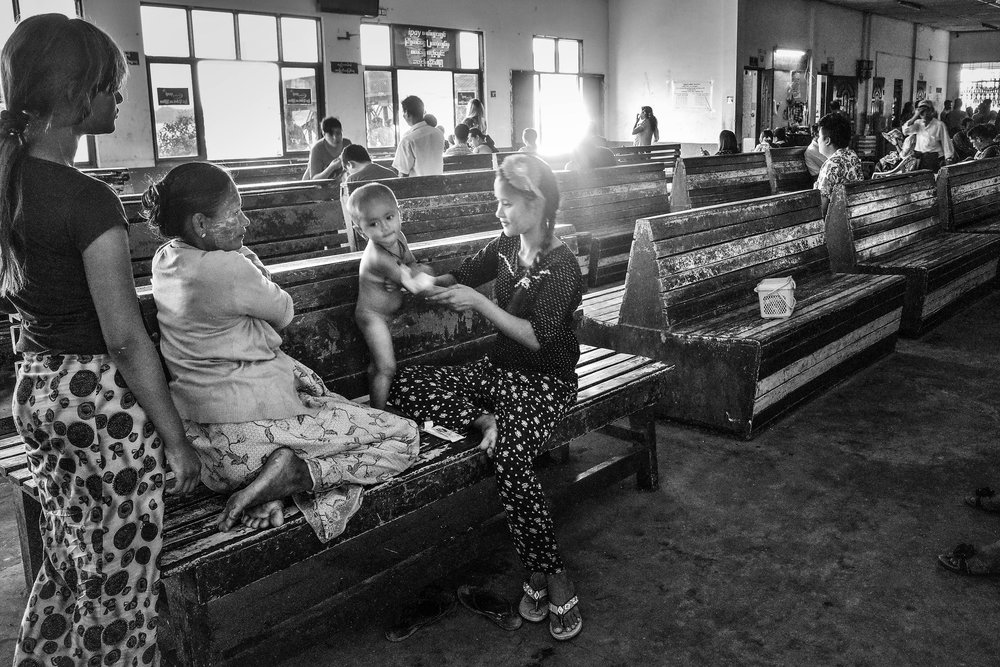
We spent some part of the next day travelling some sections of the circular train around Yangon. It was a nice experience as you meet people from all walks of life, students, pedlars, office workers … and you can hop on and off whenever you want. People are friendly on the train, ready to start conversation and if you had no time or no mood for breakfast in the morning you can always buy cakes or fruit from vendors that get on the train.
Click on any image to enlarge
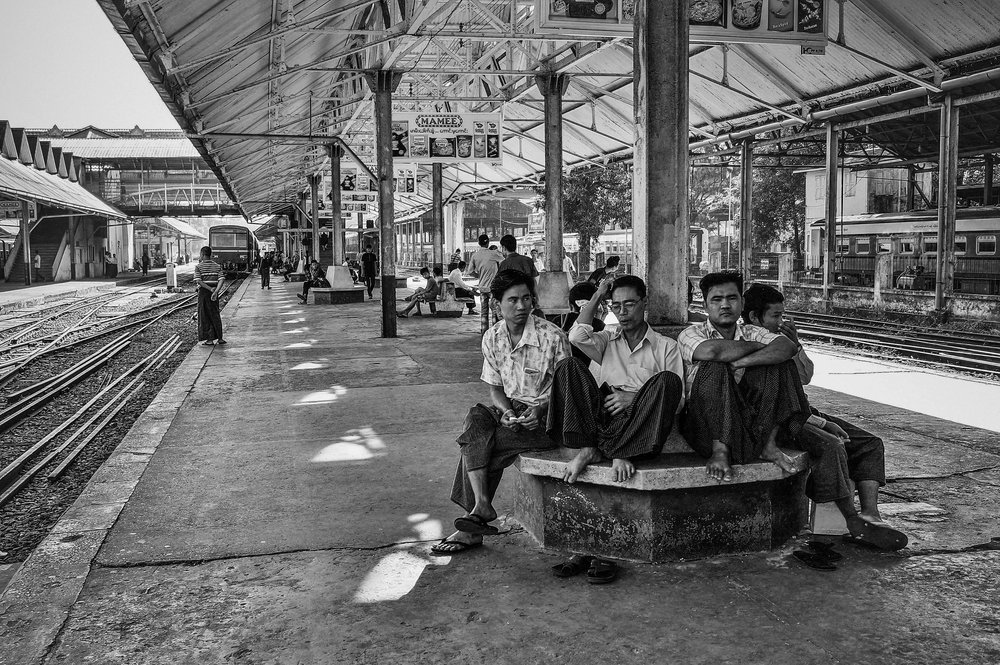
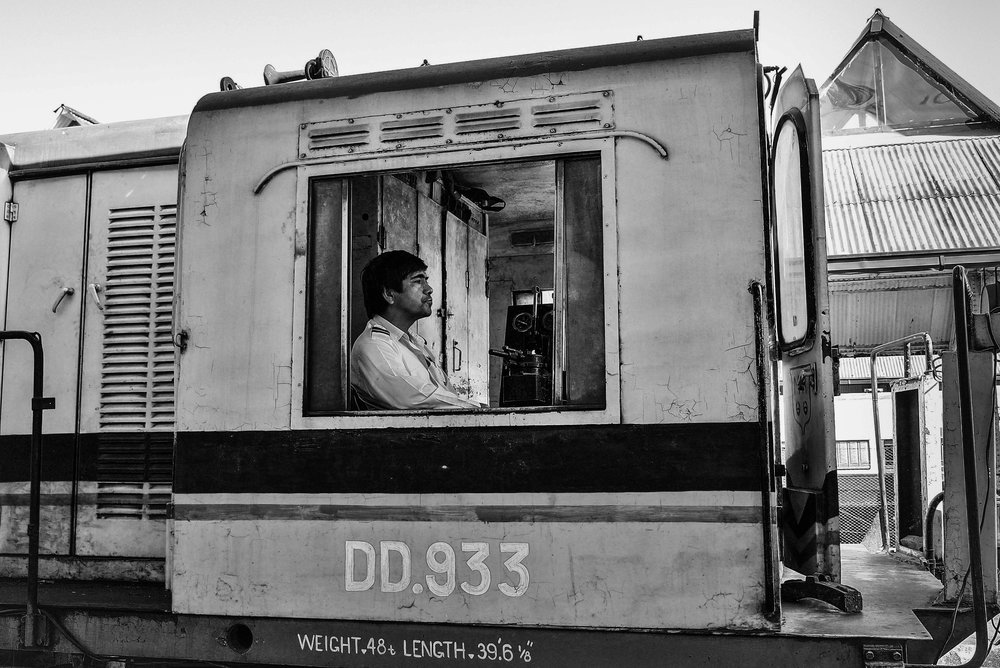
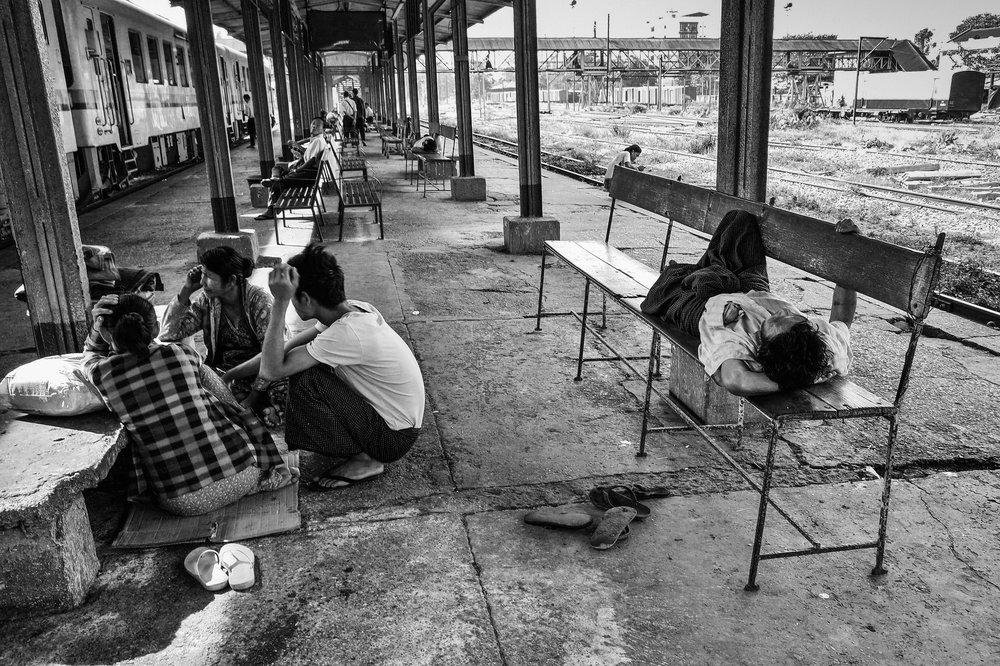
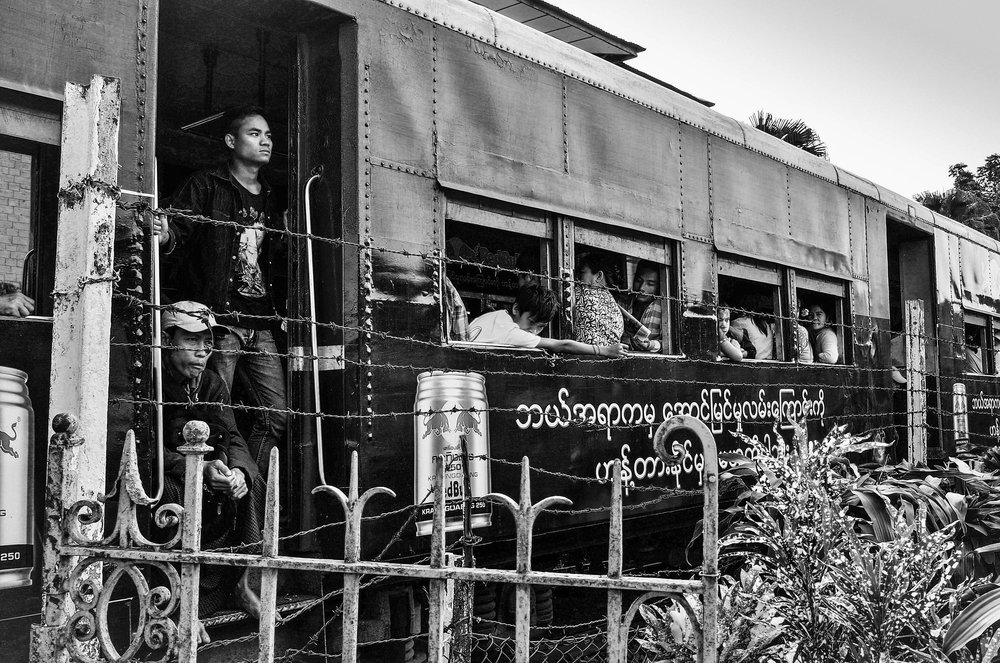
Of course a visit to any city would not be complete without visits to local markets. I’ve always thought that markets are the soul of a city wherever you are. In Yangon it’s an explosion of smells and colours (sorry for the black and white), scores of people milling around the vendors, squatting, touching the fruit having a short conversation probably bargaining. I could spend half a day and not get tired of it.
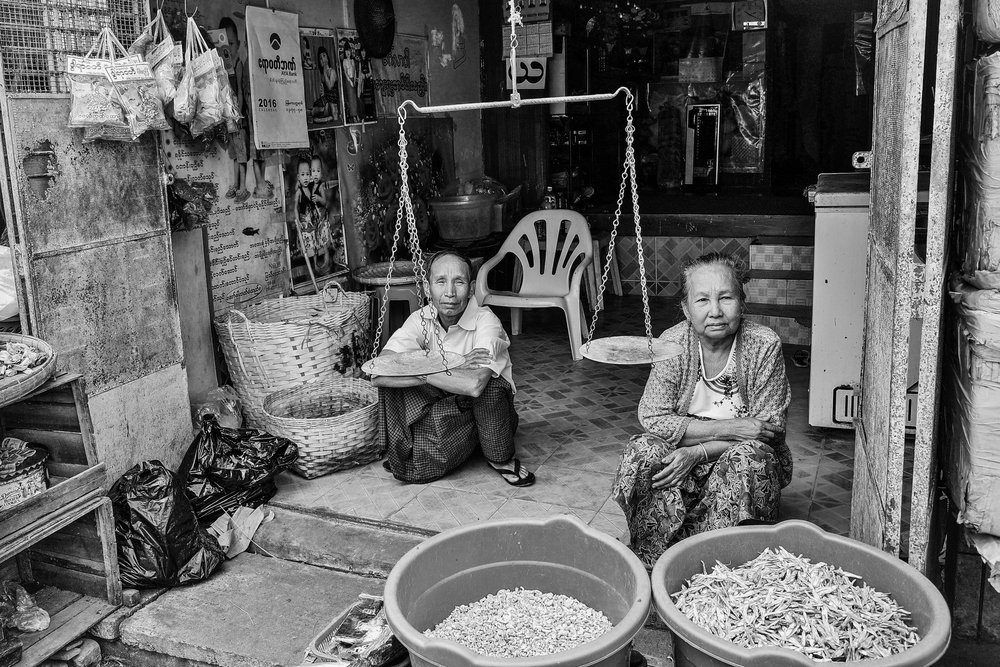
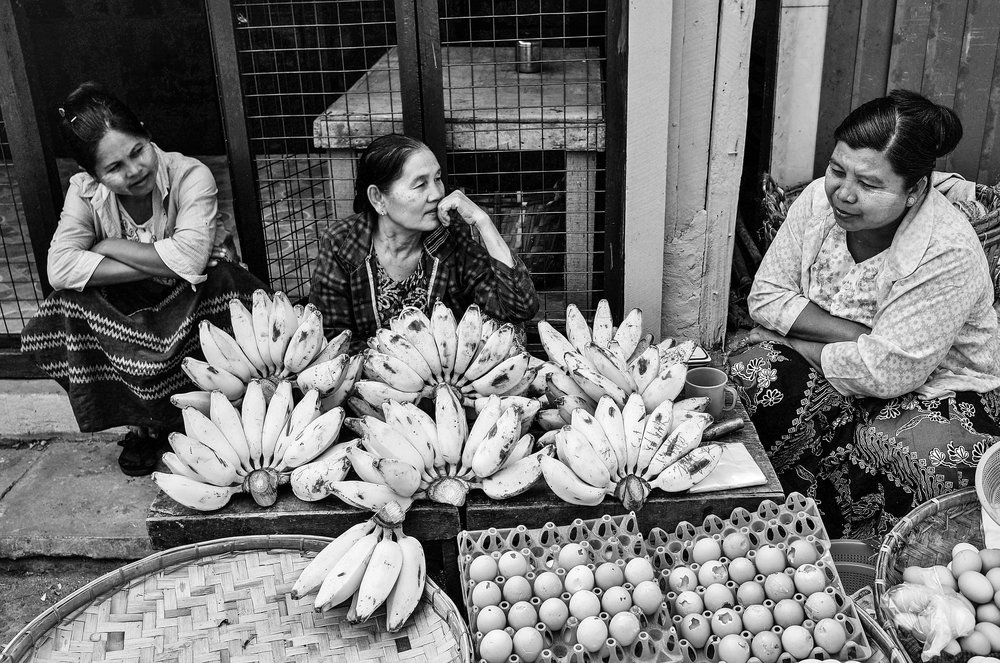
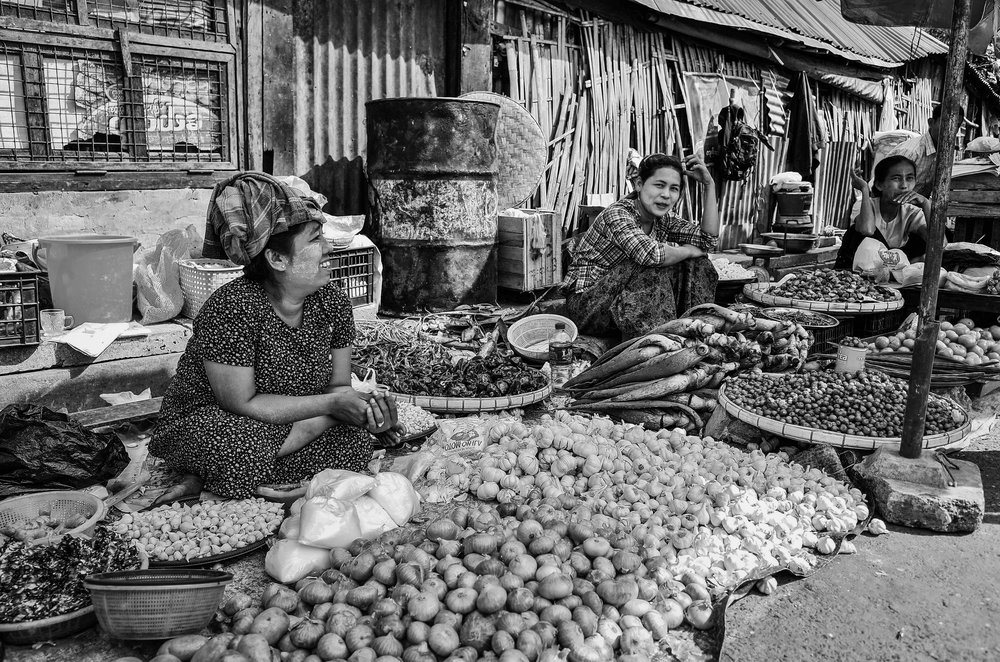
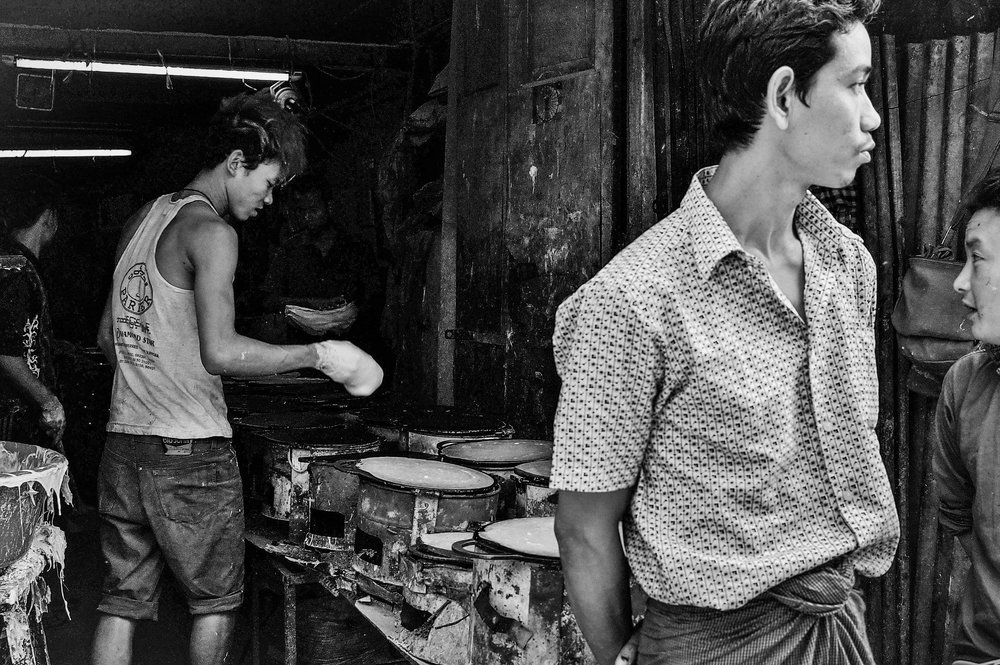
You also have many rickshaws that line the street of the markets.
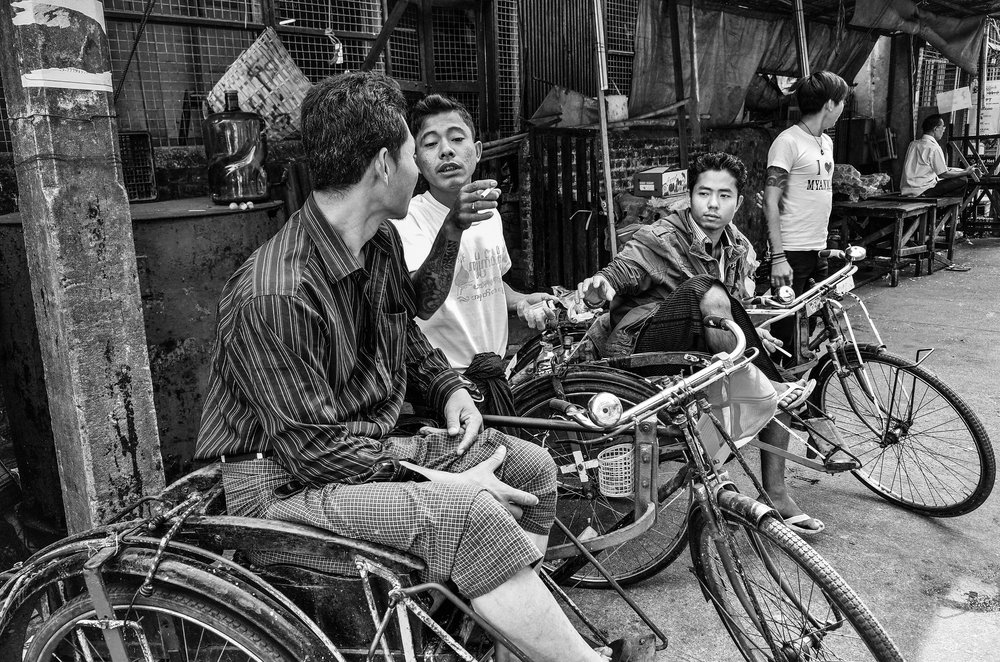
A visit would not be complete without visits to the various pagodas in town, including the Shwedagon. It’s amzaing to see how religious people are, praying sticking little leaves of gold on the Buddha statues in the pagodas or praying or consulting their smartphones. Teams of sweepers, one different team for each day of the week, keep the Shwedagon spotlessly clean.
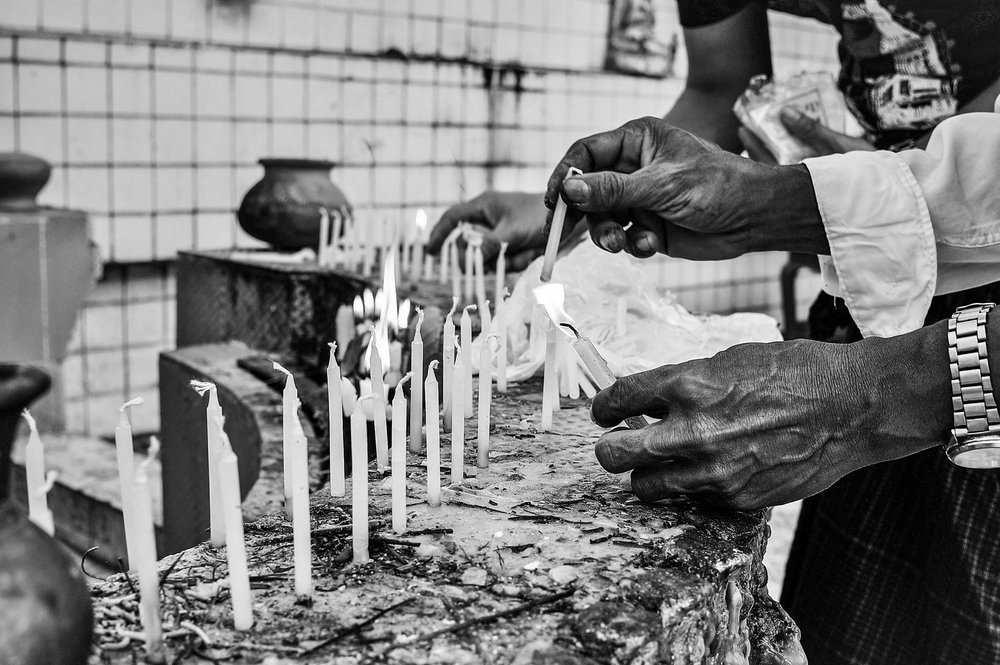
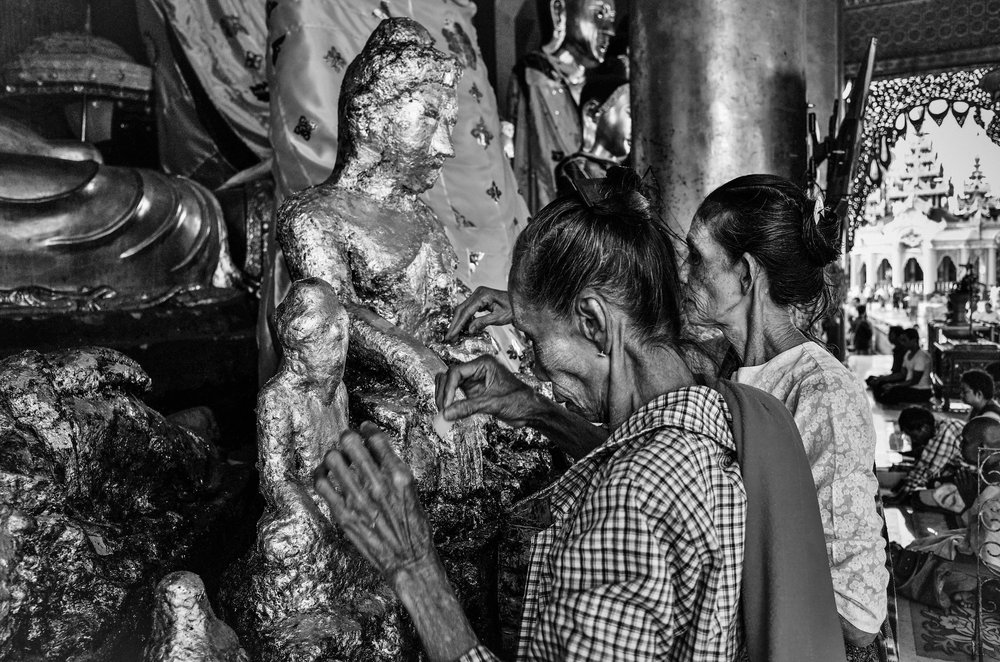
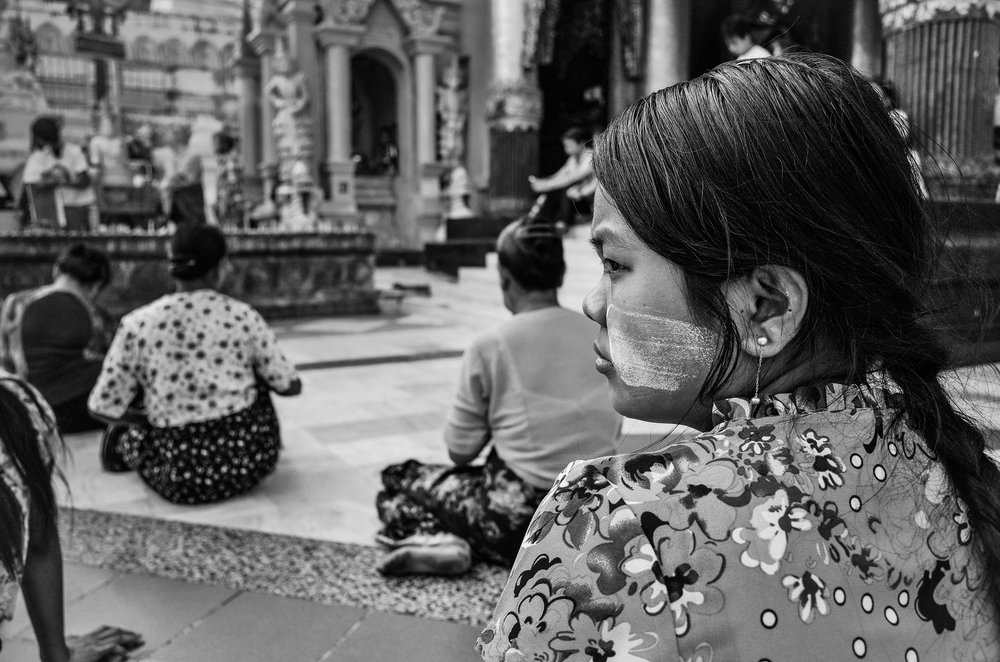
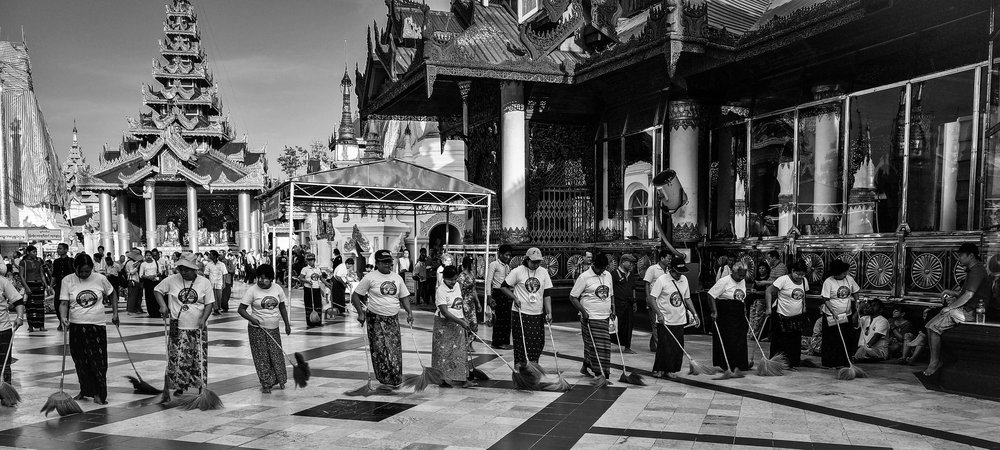
Despite its decaying buildings covered with monsoon fungi, its anarchic electricity network, Yangon is a wonderful city that is well worth visiting.


Ooops – what’s happened to the typeface?
Just decided to have a change… don’t you like Times Roman? Perhaps I should increase the line spacing a bit…. All part of my experiments for future appearance.
Not so easy to read on a phone (..nor on a Mac..) as the point size seems to have been reduced, too ..and Times seems so, er, "undistinguished". The previous sans serif was – for me, anyway – much smarter!
Sorry: "Monsal Gothic"!
Good point. I will change it back!
Very distinguished again now!
Jean,
An excellent article, thanks. I particularly enjoyed your compositions and the way the photos illustrated the story so well. Also the way you used the Ricoh ‘zooming with the feet’ to capture the gestures. I’m looking forward to the next part.
Kevin
Thanks Kevin
Feet are indeed the best zoomunless you are on top of cliff or next to a lion or a tiger or a crocodile.
Jean
Absolutely fantastic, Jean.
The GR has always seemed to have an affinity for Monochrome output, and your reinforce that opinion. I particularly like the train driver pic, how he is framed in the cabin and his stoic, attentive look into the distance.
Most of these work extremely well with the documentary feel of mono, though i do confess some curiosity of the colours in the fruit/market shots.
Looking forward to parts 2 and 3.
Thanks Jason
some photos are coming in colours.
Jean
Great images Jean.
You have an ability draw special pictures out of everyday scenes. Subjects, composition and light – the rail station and platform are favourites for me.
I wonder how much the use of the very discrete GR contributes to those outcomes as well.
And I’m with John S below that I’d love to see some of the images in colour. I suspect that there’s a richness in there just waiting to be released.
Thanks Wayne
The ricoh is indeed an unobstrusive camera even with its lens shade and it’s UV filter. Basically it’s a black box with no sexy look and no frills at all and the shutter is totally silent which allows you to get quite close without frightening people. The screen is good enough to show people their picture after taking it. I guess the kindness of the people I have photographed has also helped a great deal. I see that camera as social companion which helps to get into contact with people.
You need to buy an extender to fix a filter and lens shade but it’s a security especially with dust with the retractable lens. As you’ve probably heard of the dust issue has been quite a embarassment with the camera since it went on sale and I don’t know if it will be fixed with the new model that is due later this year. If you wish to see the colour versions of the images I suggested John to get my email through Michael and I can send you copies of them. The next parts will be in colour.
Jean , these really are very good however I do have one question to ask -and please understand that I am very biased on this-but Myanmar is such a wonderful colourful country so why are the photos in black and white?
I feel/know that they would be even better in colour.
Hello John,
I do understand your criticism and gladly accept it. Myanmar and all the countries I’ve visited in Asia are colourful places and some images work both in colour and black and white (not all of them of course).When I started the Myanmar articles I wondered what to do for Yangon?
I’ve been a black and white shooter for many years. I started photography taking black and white pics and have always printed with ilford paper mat grade 4. That might be the unconscious reason.
Then, I think that in some cases colours can be distracting and black and white allows you to concentrate on all the elements you include within the frame. Your eyes can be distracted by a dash of colour somewhere in the frame. I usually keep copies of both colour and black and white for some of my images. Some black and white images look more effective to my eyes. You might have sometimes tried to convert your colour images into black and white yourself. I often browse through your flickr account and I sometimes say to myself, that would be a great black and white image. Had I taken some of your photographs I would personally have tried to convert some of your Romanian and Oman shots into black and white, just to see how they render and keep a copy of both.
Finally even if the photos are originally in colour, the conversion of the ricoh files into black and white is amazing. I don’t know what it is with that little camera but the conversion with very little postprocessing works wonder.
I’d also like to thank for enticing me into buying my X2. It’s been my travel camera eversince and it has allowed me concentrate on composition even more than the ricoh.
The next articles on myanmar (at least parts 3 and 4) will be in colour but you gave me an idea idea of mixing both black and white and colour for part 4 though I believe it would lack unity. If you wish to see the colour version of the shots ask Michael my email address, send me a message and I will send them to you.
Jean
I love the images Jean, and am looking forward to the follow on articles, just hope work gives you enough of a break to get to the end of the series. I know balancing work, life and our passions can be challenging at times.
Thanks David,
I’ve started working on part 3 as I did have a not too pleasant day at work. writing is the consolation and so is the idea of having 3 more years to go at work before retirement.
I wholeheartedly agree that pic decided me on purchasing X series, for which I am indebted to John S.
So am I. I picked my 2nd hand X2 after seeing John images
Marvelous, I especially like the hands lighting the candles and the concentration on the faces of the people cleaning the statue, can’t wait for part two, thank you. Think you have rivaled John S king of X1, giving us a taste of Myanmar.
Thanks John
John S Mr X1 did wonderful photos of Myanmar and the article he wrote at Steve Huff photo site back in 2012 is really excellent. There’s one especially with a bull-cart and a ray of light that comes slantways which, to my eyes is really amazing. There will be a part 3 and 4 as well but I need writing the last episodes between bouts of work.
Absolutely top-flight documentary, which succeeds both as documentary and as fascinating imagery. The camera seems to have served you very well, or rather, you made it do what you wanted! If I had to pick a favourite, it would be the bananas with the women, though a very narrow win over the one William chooses.
Thanks John
The ricoh works wonder and I’m often torn between using it and my X2. The ricoh black and white high contrast setting is absolutely amazing once you get the contrast you want and the X2 is amazing and beats the ricoh any day for colour. Back to the bananas I guess I was lucky as it is one of those suspended moments that happens few times a year.
Superb photos Jean. The combination between your great eye, the friendliness of the people and the small camera helped you to get some great pictures. The last one of the line of sweepers is absolutely superb. It is one of the best photos that I have seen on Macfilos for quite some time. I tried something similar with a cleaner in a Russian Orthodox Church last year, but your one with its mix between the line of sweepers and the wonderful architecture is really wonderful. Black and White really makes this, as colours would have been distracting. Indeed, the B+W treatment works well on all of your photos and you need not apologise for it.
William
I will second that, William. I sometimes get too close to things and, of course, I have been working with Jean’s photos for some weeks before publication. But seeing them up on the site demonstrates just how good they are. There is a Part II edition in the pipeline so more good things to come.
I’ll never thank you enough Michael for the wonderful job you are doing connecting photographers with macfilos and editing articles. Part 3 on the way.
Have a nice and here really cold weekend
Jean
Thanks for the compliment. I’d like to see the pic of the cleaner or maybe see it if you did post it on Macfilos. I guess everyone of us gets torn between black and white or colour and sometimes it is a tight call between the two. I usually shoot colour and then turn the images to black and white in LR But sometimes I do wish I just had shot the ricoh with adjusted black and white high contrast mode. there’s a nice rendering with the canson PrintMaking rag 310 gr/ M2.
If you search for Russia on this site you will find my article (not the one about the Russian lens). You will see the cleaner photo in the section titled Sergiev Posad, which is the place where Russian Orthodox monks are trained. One thing which the Orthodox churches sometimes have in common with Buddhist temples are golden domes.
William
Thanks I’ll have a look right now